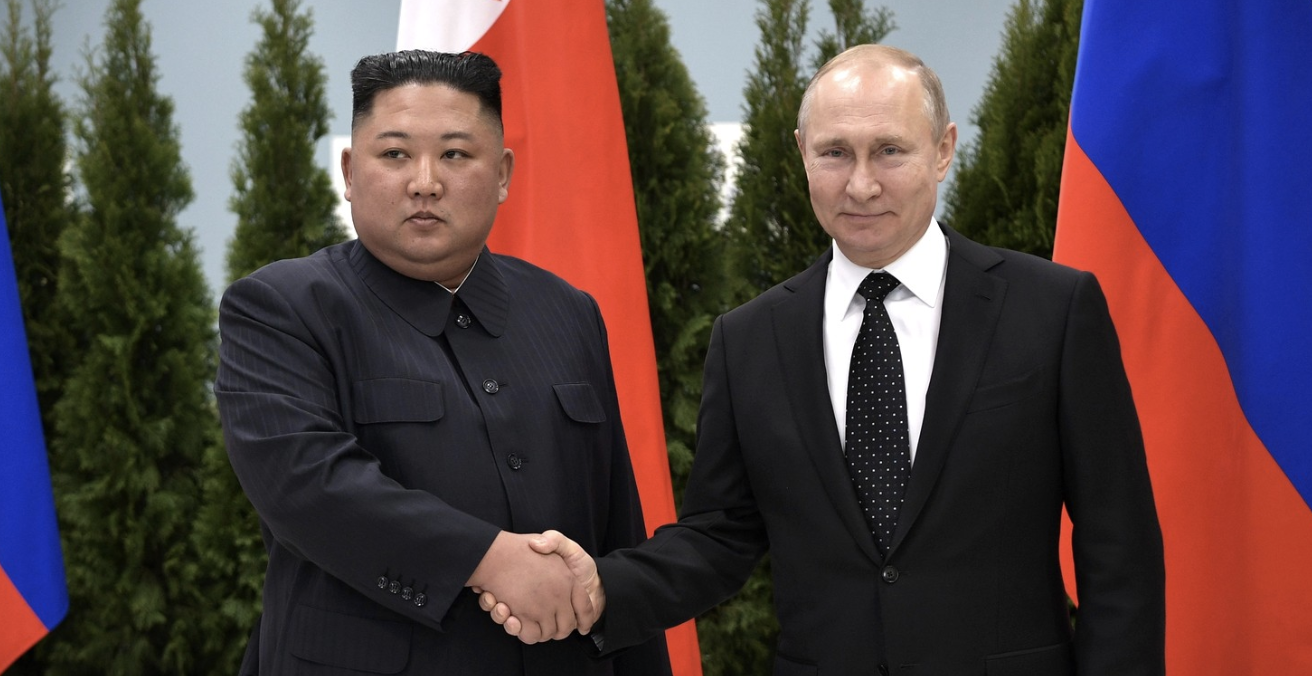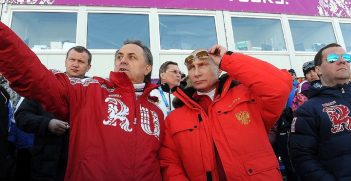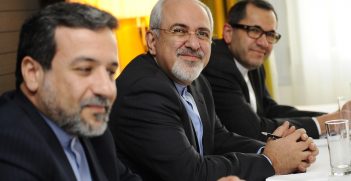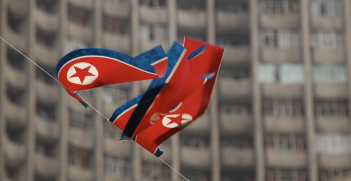The Putin-Kim Summit: Nuclear Politics, Sanctions and the Infrastructure Prize

Russian President Vladimir Putin and North Korean leader Kim Jong Un met in Vladivostok on the 25 April. While no agreements were signed, Chairman Kim got another opportunity to boost his legitimacy through the prestige of leader-to-leader diplomacy and President Putin to explore the possibility of dealing Russia back into Northeast Asian diplomacy and to network Russia into the East Asian economy.
The inter-Korean and US-North Korean summits of the past 18 months have generated a media circus internationally as the threat of imminent conflict spurred an unprecedented flurry of diplomatic activity. The door appeared to open for the prospect of a peace agreement to end the Korean War and take the heat out of the Korean nuclear crisis.
This week, Russian President Vladimir Putin and North Korean leader Kim Jong Un convened in Vladivostok. No documents were signed, or official statements issued. It was a more low-key affair than the aforementioned summits but no less important for the future of Northeast Asia. But Supreme Leader Kim got another opportunity to bask in the pomp and prestige of leader-to-leader diplomacy. He was able to further legitimise himself as a world statesman, and in the process court other suitors to leverage against the United States. For his part, President Putin arrived to explore opportunities for dealing Russia back into Northeast Asian diplomacy and to network Russia into the East Asian economy.
Sanctions relief for North Korea
Supreme Leader Kim came to Vladivostok looking to explore opportunities to loosen the United Nations Security Council (UNSC) economic sanctions regime. Specifically, discussions centred on the status of North Korean nationals working in Russia, whose incomes are an important source of remittances to relatives in the Democratic People’s Republic of Korea (DPRK) itself. The UNSC sanctions, which Russia voted in favour of, mandate that these North Korean workers need to be expelled and repatriated back to the DPRK by the end of the year. Prior to UNSC Resolution 2375, negotiated in the wake of the DPRK’s sixth nuclear test in 2017, there were approximately 30,000 North Koreans working in Russia, of which around 11,000 remain. Nearly 85 percent of North Korean migrants work in construction, with the remainder employed in the textiles, agriculture, catering, traditional medicine and logging industries.
In his post-summit press conference, President Putin seemed to imply an inclination to support a relaxation of the expulsions, stating: “There are several different options here. There are humanitarian issues, and there are issues related to the exercising of these people’s rights. There are smooth, non-confrontational solutions. I must say that the Koreans work well for us, never giving the local authorities any trouble. They are very hard-working people, law-abiding and disciplined.” The signalling here conforms to Russia’s broader position that sanctions relief should be part of a gradual, incremental disarmament agreement between the DPRK and the United States. Given the now discernible observation that North Korea will never relinquish its nuclear weapons program, Russia’s position on sanctions relief, in practical terms, implies tacit support for a nuclear-armed North Korea that presents strategic problems for both the United States and China. That’s the crack through which Russia can re-insert itself as a relevant actor in Northeast Asia politics.
Nuclear politics and Russia’s role in Northeast Asia
While Russia voted in support of UNSC resolutions condemning North Korea for its nuclear and missile tests in 2017, its understanding of “denuclearisation” of the Korean Peninsula more closely aligns with North Korea’s interpretation of a nuclear-free Korea that includes the full nuclear weapons relinquishment of the United States as well; as opposed to Washington’s long-standing “complete, verifiable, irreversible denuclearisation” (CVID) doctrine. As Anastasia Barannikova wrote for the Bulletin of Atomic Scientists, denuclearisation of the Korean Peninsula would likely need to entail the removal of the US nuclear umbrella over South Korea, at the least.
President Putin also hinted at Russian interest in the revival of the Six-Party Talks as a forum for negotiating collective security guarantees for North Korea that incorporate regional states in addition to the United States. The current process of bilateral US-DPRK and inter-Korean summitry limits Russia’s regional influence in Northeast Asia. The original Six-Party Talks were important for Russia as they provided Moscow with a vehicle for influence in a region dominated by the United States and China. A revived six-party forum could deal Russia back into the game.
Economic integration into Northeast Asia: The real prize for Russia
Russia’s need to be dealt back into the game is driven by the economics of frontier development. Traditionally the Russian far east has been a frontier region valued largely for its raw materials but considered strategically vulnerable to incursion from the southeast because of its sparse population and remoteness from European Russia. The economic development of the Russian Far East depends on its incorporation into the northeast Asian economy, and it is the Korean Peninsula that is the key to this development strategy. This strategy hinges on the establishment of hydrocarbon energy pipelines, railway corridors through North Korea to South Korea, and potentially Japan, and an ice-free, deep-water port at Rason in the DPRK’s northeast. This is intended to create new market opportunities for Russian oil and gas and to open new trade corridors between Europe and South Korean and Japan.
This development vision has a long pedigree. As early as 1995, the governments of China, Russia, North Korea, South Korea and Mongolia had signed an agreement to develop the Tumen River tri-border area (near the intersection of the Chinese, Russian and North Korean borders) featuring a US $20 billion port at Rason and free economic zone located nearby at Fángchuān. More recently, the Chinese border town of Hunchun has become a development hub in this area, linked to China’s high-speed rail network. Russian interests have financed an upgraded port facility just across the border in the nearby Rason special economic zone in North Korea. The uncertainty surrounding Korean nuclear politics has been the primary barrier to further investment in infrastructure integration to fulfil this development vision.
The inter-Korean summits of 2018 appeared to breathe new life into this development vision. South Korean President Moon Jae In’s engagement strategy with North Korea has been based on a broader push by South Korea to integrate Northeast Asia via the New Northern Policy. The strategy is aimed at buttressing regional security through economic and infrastructure linkages, or “nine bridges,” between South Korea and Russia in the form of gas pipelines, railway connections, seaports, regional electricity grid integration, Arctic shipping routes, shipbuilding, labour exchange and the co-development of agriculture and fisheries projects.
Right up to the summit between President Donald Trump and Supreme Leader Kim in Hanoi in February, it appeared the United States and North Korea were going to negotiate an agreement that would relax UNSC sanctions enough to remove the political obstacles to further development of these infrastructure projects. The failure of Trump and Kim to reach agreement in Hanoi, at least temporarily, have again put the brakes on these projects. President Putin cited this specifically as the key impediment, stating: “Apparently, there is a shortage of sovereignty during the adoption of final decisions, and the Republic of Korea has certain allied obligations before the United States.”
North Korean leader Kim’s economic modernisation drive means that extensive opportunities for infrastructure development are going to open up in North Korea for foreign investors when the political climate eventually warms sufficiently. The contours of a contest are beginning to coalesce and South Korean, Chinese and Russian interests are beginning to jockey for position to develop this relatively untapped space. Indeed, the modernisation of the North Korean economy and infrastructure is a prize that has been underappreciated by many analysts of Korean Peninsula affairs.
Dr Ben Habib is a lecturer in International Relations at La Trobe University. He is an internationally published scholar researching Korean Peninsula security, transnational environmental movements and international climate politics.
This article is published under a Creative Commons License and may be republished with attribution.





